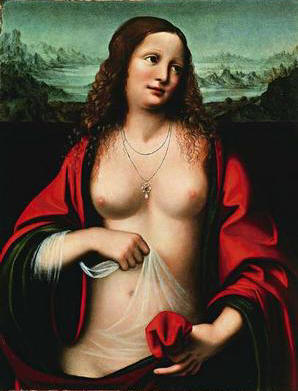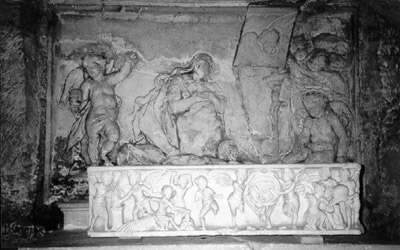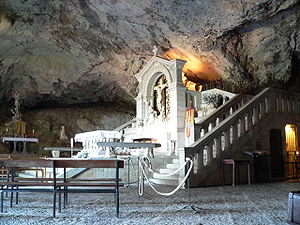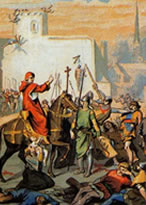Mary Magdalen of Bethany - Sister of Lazarus
Hospitaller Order of St. Lazarus of Jerusalem is also connected to
Mary Magdalen of Bethany - sister of Lazarus - and the Holy Grail
44-69AD - The 70
disciples of Jesus Christ - Lazarus
and Mary Magdalen landed at the place called Saintes-Maries-de-la-Mer
near Arles - France
62AD - Joseph
of Arimathea with 12 missionaries landed on the Isle of Britain in 62 AD.
- Philip
the Apostle sent twelve Christians to Britain, one of whom was, Joseph of
Arimathea
530 - The Order
of Saint Lazarus established leper hospitals with the first being in Jerusalem
in the year 530 - Burton
Lazars
Lazarus
- is a name found in two separate contexts in the New Testament. Lazarus
of Bethany is the subject of a miracle recounted only in the Gospel of
John,[1] in which Jesus restores Lazarus to life after four days dead....He
is identified as the brother of the sisters Mary and Martha. ...
...
The Military and Hospitaller Order of St. Lazarus of Jerusalem (OSLJ) was
a religious/military order of chivalry which originated in a leper hospital
founded by Knights Hospitaller in the twelfth century by Crusaders of the
Latin Kingdom of Jerusalem.
The Order of Saint Lazarus is one of the most ancient of the European orders
of chivalry, yet is one of the less-known and less-documented orders.
The first mention of the Order of Saint Lazarus in surviving sources dates to
1142.

Mary Magdalen by Da Vinci. Note she is holding a thin "veil"
over her reproductive area and a red cloth in her left hand.
She was the "bleeding woman" whose bleeding stopped when "power
went out from" Jesus. A woman's bleeding stops when she becomes pregnant..
Mary_Magdalene
-
The French tradition of Saint Lazare of Bethany is that Mary, her
brother Lazarus, and Maximinus, one of the Seventy Disciples and some
companions, expelled by persecutions from the Holy Land, traversed the
Mediterranean in a frail boat with neither rudder nor mast and landed at the
place called Saintes-Maries-de-la-Mer near Arles. ... Lazarus became,
after the death of the good Maximin, the first bishop of Marseilles
Carthusian prior: Polycarpe de la Rivière
...

The strange crypt of Lazarus and the fresco of Mary Magdalene - St Victor,
Marseille.
...the research Peiresc did, and with which the Carthusian monk
maintained a close correspondence, was very often directed in the direction of Mary
Magdalene and Lazarus, two enigmatic characters from the New Testament, who
legends place in France after the Crucifixion. It is in Marseilles, under the
abbey fortress of St Victor, that he made in-depth studies on the crypt of Mary
Magdalene, St Andre, and Lazarus!
Lazarus of whom alone we have to treat here, went to Marseilles, and, having
converted a number of its inhabitants to Christianity, became their first
pastor. During the first persecution under Nero he hid himself in a crypt,
over which the celebrated Abbey of St.-Victor was constructed in the fifth
century.
In this same crypt he was interred, when he shed his blood for the faith.
During the new persecution of Domitian he was cast into prison and beheaded in a
spot which is believed to be identical with a cave beneath the prison
Saint-Lazare.
His body was later translated to Autun, and buried in the cathedral of that
town. But the inhabitants of Marseilles claim to be in possession of his head
which they still venerate.
Sainte-Baume

The French tradition of Saint Lazare of Bethany is that Mary
Magdalene, her brother Lazarus,
and Maximinus, one of the Seventy
Disciples and some companions, expelled by persecutions from the Holy
Land, traversed the Mediterranean in a frail boat with neither rudder nor mast
and landed at the place called Saintes-Maries-de-la-Mer
near Arles.
Mary Magdalene came to Marseille and converted the whole of Provence.
Magdalene is said to have retired to a cave on a hill by Marseille, La Sainte-Baume
("Holy Cave", baumo in Provencal), where she gave herself up to a life
of penance for thirty years. The cave is now a Christian pilgrimage site.
Saint-Maximin-la-Sainte-Baume
The cult
of Mary Magdalene
The little town was transformed by the well-published discovery, 12 December
1279, in the crypt of Saint-Maximin, of a sarcophagus that was proclaimed to be
the tomb of Mary Magdalene, signalled by miracles[1]
and by the ensuing pilgrim-drawing cult of Mary
Magdalene and Saint Maximin,
that was assiduously cultivated by Charles
II of Anjou, King of Naples. He founded the massive Gothic Basilique Ste.
Marie-Madeleine in 1295; the basilica had the blessing of Boniface
VIII, who placed it under the new teaching order of Dominicans.
The founding tradition held that relics of Mary Magdalene were preserved
here, and not at Vézelay,[2]
and that she, her brother Lazarus,
and Maximin, a 3rd-century martyr who was now added to earlier lists of the Seventy
Disciples, fled the Holy Land by a miraculous boat with neither rudder nor
sail[3]
and landed at Saintes-Maries-de-la-Mer,
in the Camargue
near Arles. She
then came to Marseille
and converted the local people. Later in life, according to the founding legend,
she retired to a cave in the Sainte-Baume mountains. She was buried in Saint-Maximin,
which was not a place of pilgrimage in early times, though there is a Gallo-Roman
crypt under the basilica. Sarcophagi are shown, of St Maximin, Ste. Marcelle,
Ste. Suzanne and St. Sidoine (Sidonius) as well as the reliquary, which is said
to hold the remains of Mary Magdalene.
Construction of the basilica, begun in 1295, was complete as to the crypt
when it was consecrated in 1316. In it were installed a Gallo-Roman
funerary monument—of the 4th century in fact—and four marble sarcophagi,
whose bas-reliefs permit a Christian identification. The Black
Death in 1348, which carried away half the local population, interrupted the
building campaign, which was not taken up again until 1404, but found the sixth
bay of the nave complete by 1412. Work continued until 1532, when it was decided
to leave the basilica just as it was, without a finished west front or portal or
belltowers, features that it lacks to this day. The plan has a main apse flanked
by two subsidiary apses. Its great aisled nave is without transept. The nave is
flanked by sixteen chapels in the aisles.
Mary_Magdalene
Western tradition, however, includes the idea of Magdalene settling farther
north and west. How a cult of Mary Magdalene first arose in Provence
has been summed up by Victor Saxer[8]
in La culte de Marie Magdalene en occident (1959).
Mary Magdalene's relics
were first venerated at the abbey of Saint-Maximin Vézelay in Burgundy.
Afterward, since September 9, 1279, the supposed body of Mary Magdalene was
also venerated at Saint-Maximin-la-Sainte-Baume, Provence.
This cult attracted such throngs of pilgrims that the earlier shrine was rebuilt
as the great Basilica
from the mid-thirteenth century, one of the finest Gothic churches in the south
of France.
St. Maximinus of Aix - Saints & Angels - Catholic Online
First bishop
of Aix, in Provence, France, reportedly one of Christ’s seventy-two disciples
and a companion of Sts. Mary
Magdalen, Mary
Cleopas, Martha, and Lazarus. In one account, Maximinus is called “the man
who had been blind from birth.”
The Christian History of France Christian Assemblies International
The Origin of France and of the French people
The French are not a single, homogenous people. France, once called
“Gaul”, was settled by Celts who migrated to the South of Gaul in 800 BC.
These Celtic Gauls were in fact dispersed Israelites, most likely from the tribe
of Reuben. In
about 600 BC the Phocaeans, a Greek tribe, founded Massalia (Marseilles),
France’s oldest city, which also features France’s most ancient harbour.
Marseilles was populated by Celts, Greeks and even Phoenicians, and played a
crucial role in the development of trade with Greek cities, Northern Europe and
even the Atlantic, by which tin from England was transported. The Franks –
Germanic people from central Europe – then settled in France in the early
third century AD. Additionally, the Vikings from Norway, led by King Rollo in
911AD, settled the area of Normandy, the “Northmen” eventually becoming the
“Normans”. They were also of Israelite descent. Thus the ethnic make-up of
ancient France was quite mixed, with a sizeable portion of the population
descended from the wandering and exiled tribes of Israel.
The First Christians in France
France received its Christianity directly from Jerusalem in the first century
BC. After Christ’s death, Christians were persecuted in Jerusalem and in all
cities of Palestine. Joseph of Arimathea, Lazarus (resurrected
by Jesus), Mary Magdalene, and several other followers of Jesus
were all exiled from Israel, and set afloat by their persecutors in an oar-less
boat without sail. The boat miraculously reached an area near Marseilles (called
today “Les Saintes Maries de la Mer” or “The Holy Mary(s) from the
Sea), where Philip had already settled down and begun to preach the Word.
Joseph of Arimathea was the Virgin Mary’s uncle. He was a
tin trader who was well known in Marseille, as his ship would stop there on its
way to the tin mines in England. Joseph (with some other disciples) then
continued northwards through Gaul, passing through Limoges and Roscoff and
across the English Channel before finally reaching Cornwall, where he
established the first Christian Church in England (see Christian
History of Britain).
Philip (one of Jesus’ twelve disciples) had been given the
responsibility of spreading Christianity in Gaul (France), and had commissioned
Joseph of Arimathea to help him. Joseph and his group had been in Avalon (modern
day Glastonbury, in Cornwall, England) for about four years. During that time,
Philip’s disciples won people for Christ and started schools and churches.
Philip had sent about 160 Christians from Gaul to be trained by Joseph. In
return, Joseph sent many of the workers back to Gaul, including most of the
original group that had come with him.
The first one he sent was Lazarus, who was sent to Massialia
(Marseilles); Maximin who was “the rich young ruler” and one of the
seventy sent out by Jesus, went to Aix. Mary Magdalene, Mary Salome (mother of
James and John) and Mary, wife of Cleopas, went to Camargue; Eutropius went to
Saintes (in Aquitaine) and later to Orange, Arles and Tarascon. Saturninus went
to Toulouse; Martial went to Limoges and Parmenas (one of the deacons mentioned
in ACTS
6:5) went to Avignon. Restitutus (the blind man healed by Jesus in JOHN
chapter 9) also went to Aix; Zaccheus (who accompanied Joseph of Arimathea)
settled in Rocamadour and Sergius Paulus, a deputy of Paphos (the “prudent
man”
in ACTS
13:7-12) went to Narbonne. Many others who were sent as missionaries to
Gaul/France could be mentioned. It should be noted too that Pilate was banished
from Jerusalem to Vienne (South Lyon) in AD 38 and Herod Antipas was banished to
Lyon in AD 39.
The Albigenses
 The
massacre of Bezier
The
massacre of Bezier
The Albigenses (also called “Cathars”) originated in the
area of Albi and Toulouse around 1100 AD. A revival “wind” came from Eastern
Europe, bringing the light of the Gospel to the common man. The Albigenses were
“reformers before the reform”, believing in salvation through receiving the
Holy Spirit and being changed by the Word. They read the Bible in the common
language (The Latin Vulgate ), which was forbidden by the Roman Catholic church.
As a result, they were accused of heresy for using a non-Catholic Bible. They
increased so rapidly that many cities were inhabited exclusively by them, and
several eminent noblemen embraced their doctrines. Among the latter were Raymond
VI, Earl of Toulouse, and the Earl of Foix.
The Waldenses
Many people place the Waldenses as having started in the
12th century, but they date their lineage as being much earlier. Their teaching
can be traced back to the 4th century. Although many churches along the
centuries had already been brought under the power of the Papacy, Bible doctrine
was still preached in many of the churches of Lombardy and Piedmont. Images were
removed from churches, justification by faith was preached, and purgatory and
the use of relics and pilgrimages to attain merit were rejected.
In 1059 the churches in Northern Italy submitted to the pope, and though the
plains were conquered, the mountains remained free. Those who did not want to
submit fled into the Cottian Alps of North-West Italy. The Bible-believing
churches held a strong evangelical testimony and were fiercely persecuted. Some
of the Christians crossed the Rhine and preached the Gospel as far as Cologne,
where they were branded as Manicheans, and many were burned at the stake.
In 1173, Peter Waldo, a wealthy merchant from Lyon, France, was converted.
Some say that he received his surname through his association with the Waldenses,
who most certainly had an evangelical testimony before the time of Waldo. While
a majority of historians name Peter Waldo as the originator of the Waldenses,
the Waldensian ‘Noble Lesson’ dates from at least the year 1100, long before
Waldo was born. Waldo was excommunicated in 1183, after being denied the right
to preach. His followers were dispersed, and a number of them fled to the
Waldensian Valleys. The great Dominican persecution of the Albigenses began in
the 13th century. Many of these Christians also fled to Waldensian safety.
The importance of the Waldenses as a cause of the Reformation is often
overlooked. They were evangelistic as well as being evangelical. They travelled
throughout southern and central Europe, often disguised as peddlers, until they
brought forth from their hearts treasures greater than the gems and silks they
sold. They penetrated into Spain, and went as far east as Germany, Bohemia and
Poland. Their footsteps can be traced not only by the evangelical churches that
were founded, but by the stakes upon which many were martyred. The seed of the
Gospel was often watered by the blood of those who had sowed it.



